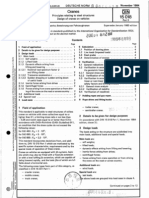DIN DIN performs the static stress check and fatigue check for the steel structures of crane and crane equipment. This had been the approach taken in the previous standard ISO Alternatively, use the Standard context menu:. There have also been a range of ISO standards published which reflect the cycle based approach by connection to ISO It is also possible that a hoist with a large hook path in the average process condition average hoisting displacement will be stressed by less load cycles than estimated in the past. 
| Uploader: | Tuzuru |
| Date Added: | 27 June 2008 |
| File Size: | 11.33 Mb |
| Operating Systems: | Windows NT/2000/XP/2003/2003/7/8/10 MacOS 10/X |
| Downloads: | 72699 |
| Price: | Free* [*Free Regsitration Required] |
The next step is for the subcommittees for mobile cranes, tower cranes, jib cranes and bridge and gantry cranes to revise their standards accordingly.

But what is new is that standards covering components and mechanisms like hoists and their associated parts: Combined utilization factor fatigue is calculated using the following formula the sign of Ufx, Ufy and Ufz are taken into the account: One of the key issues at the moment is the drive to put cycle-based classification of the components and mechanisms of the 150018-1 at the heart of the design and specification process, as is already the case for the crane structure.
Combined utilization factor fatigue is calculated using the following formula the sign of Ufx, Ufy and Ufz are taken into the account:. Another relevant standard 155018-1 already use cycle-based classification by reference to EN for components of cranes is EN The European mobile crane standard EN In terms of international standards there has been less progress but the 10518-1 has certainly started rolling.
Closing the loop
Pre-standards for sections covering the limit states and proof of competence of bearings prEN Newsletter sign up Online magazine sign up.
There have also been a range of ISO standards published which reflect the cycle based approach by connection to ISO Alternatively, use the Standard context menu: The fatigue calculations In terms of new standards, the ultimate aim is that the updated documents will present the opportunity for cranes to be more accurately classified in groups using the A-Class notation based on load cycles total number working cycles and a load spectrum dih than the previous M-Class.

These additional parameters are used to calculate the component duties and they include the total number of component working cycles of the component during the design life; the relative frequencies of loads to be handled load spectrum, state of loading ; the average displacements; and the average number of accelerations per movement.
Closing the loop 22 August Jump to page content Accessibility. DIN DIN performs the static stress check and fatigue check for the steel structures of crane and crane equipment.
The Stress fatigue can be set by the exact value or by setting the crane group and the weld type. Weld Type depends on the shape, structural design, whole pattern or type and quality of the welds. In simple terms using a limit state design method for all of the components, not just the steel structure is required to predict the life of the crane more accurately, making the machinery safer. In Europe perhaps the most well dih standard is EN General principles and requirements, which provides the cycle-based classification principles.
In parallel to this we have classifications for the product types of cranes in the ISO family given as parts like Advertise with us Terms and conditions Site Map.
Fatigue Summation" performs additional calculations and sum damage from different load groups based on stress history defined in Fatigue Group.
Closing the loop - Cranes Today
Allowable fatigue stress is divided on coefficient depends 15018- the direction and the weld type: This had been the approach taken in the previous standard ISO This means replacing the previous approach where components and mechanisms were assessed on a time-based classification system.
For power-driven winches and hoists Becker is the convenor of the group WG17 of technical committee TC reviewing these current harmonised standards and prestandards have been published FprEN Contact us Privacy Cookie Policy. Alternatively, use the Standard context menu:. Can be set from B1 to B6.
By default, the full model is set for the selection, but it is possible to edit the selection. In summary Becker says that the harmonisation of the standards remains a work in progress but that the direction of travel is clear.
The next important step then is to ensure that the standards reflect the changed approach.

No comments:
Post a Comment